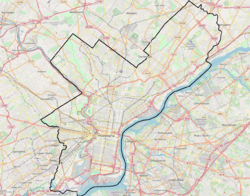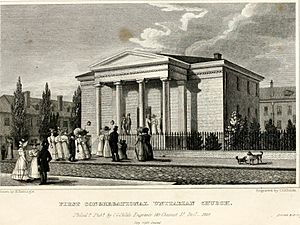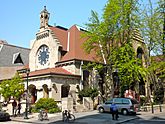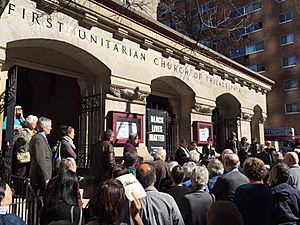First Unitarian Church of Philadelphia facts for kids
Quick facts for kids |
|
|
First Unitarian Church
|
|
 |
|
| Location | 2125 Chestnut Street Philadelphia, Pennsylvania |
|---|---|
| Built | 1886 |
| Architect | Frank Furness |
| Architectural style | Gothic |
| NRHP reference No. | 71000724 |
| Added to NRHP | May 27, 1971 |
The First Unitarian Church of Philadelphia is a special place in Philadelphia, Pennsylvania. It's a Unitarian Universalist church located at 2125 Chestnut Street. This church is also a community center. It hosts many fun and educational activities for everyone.
The church started on June 12, 1796. Twenty smart leaders in Philadelphia created the First Unitarian Society. It was the first church in the country to call itself "Unitarian" and keep going strong. A minister named Joseph Priestley helped the founders. The first main minister was Rev. Dr. William Henry Furness.
Contents
William Henry Furness: A Champion for Freedom
The church was led by its members until 1825. That's when Rev. Dr. William Henry Furness became the first minister at just 22 years old. In the 1830s, Furness became one of the few ministers in the city who spoke out against slavery. He was known for his strong sermons against slavery. He also helped people escape slavery through the Underground Railroad.
His speeches were so powerful that some church members even armed themselves. They quietly watched over him during Sunday services. This was to protect him from people who supported slavery. His strong words against the Fugitive Slave Law even made President Buchanan's team think about taking legal action against him. Furness served as minister for 50 years. He stayed involved with the church until he passed away in 1898.
The Church's Amazing Buildings
The First Unitarian Church has had three main buildings over the years. Each one has a unique story and design.
First Building: The Octagon (1813–1828)
The first church building was called the Octagon Building. It was started in March 1812 and opened on February 14, 1813. It was located at 10th & Locust Streets. Robert Mills designed it. He is thought to be the first architect born and trained in the United States.
Its eight-sided shape was unusual for Philadelphia. But it was similar to other Unitarian churches in England. These churches often used an octagon shape. This was a way to be different from traditional Christian churches. Those churches usually had a cross shape. This first building cost about $25,000 and could seat 300 people.
Second Building: The Greek Revival Style (1828–1885)
The church members wanted a bigger and more beautiful building. So, they decided to build a second one in the same spot. The first stone for the "Doric Building" was laid on March 24, 1828. Greek Revival architecture was very popular back then.
William Strickland designed this building. Books from that time described it as one of the best churches in the city. It opened on November 5, 1828. This building was the church's home until they moved to their current location in 1885.
Third Building: The Current Home (1885–Present)
Frank Furness designed the church building you see today. He was a famous architect. He also designed The Pennsylvania Academy of the Fine Arts. Frank Furness was the son of the church's first minister, William Henry Furness.
Construction started in 1883, and the church opened in 1885. It was fully finished in 1886. There used to be a tall, pyramid-shaped tower at the church's corner. But it was removed in the early 1900s.
Inside, the main worship area has a special ceiling. It's painted rust red with gold-leaf daffodils. The walls are blue. The church also has beautiful stained glass windows. These were made by famous artists like Louis Tiffany & Co. and John La Farge. Later, a large Casavant pipe organ was added.
The building also has Griffin Hall in the basement. It has a stage and a big kitchen. The back of the building has a Parish Room for meetings and a smaller chapel. The upper floors have offices, meeting rooms, and daycare facilities.
Famous People Connected to the Church
Many important people have been part of the First Unitarian Church.
- Frances Ellen Watkins Harper was a member from 1870 until she passed away in 1911. She was the first African American woman to publish her writings in the United States. She wrote stories and poems. She was also an activist who fought for civil rights, women's rights, and temperance.
- Laura Matilda Towne was one of the first women from the North to go South to help formerly enslaved people. She opened the Penn School, the first school for freedmen, during the Civil War. She lived on St. Helena Island, South Carolina, and ran the school until her death in 1901.
- Kevin Bacon grew up attending the First Unitarian Church of Philadelphia. He even had his first acting role in a holiday play there!
Important Events at the Church
The First Unitarian Church has been a part of many important moments in history.
Supporting John Brown
After John Brown was executed, his body came to Philadelphia. William Henry Furness attended a private vigil for him. Furness was a strong supporter of John Brown. He even helped Brown's wife. Furness spoke at a "Martyr Day" event in Philadelphia on December 2, 1859. His strong opposition to the 1850 Fugitive Slave Law was so notable that President Buchanan's cabinet even discussed taking legal action against him.
Martin Luther King Jr.'s Visit
In 1950, Martin Luther King Jr. was a student. He attended a lecture by Dr. Mordecai Johnson. Dr. Johnson spoke about how Mohandas K. Gandhi used non-violent civil disobedience. This idea later inspired King's own non-violent protests for civil rights. For a long time, people thought this lecture happened at the First Unitarian Church. In 2020, a historian named Patrick Duff confirmed it! The lecture took place on November 19, 1950, at 3:45 pm. King was so moved that he followed Dr. Johnson to another building and they talked late into the night.
A Welcoming Community
In April 2006, the church officially became a "Welcoming Congregation." This means they openly welcome and support the bisexual, transgender, lesbian, and gay community. In 2007, Nathan C. Walker became the church's first openly gay minister.
Supporting Black Lives Matter
In February 2016, the church joined a nationwide effort. They voted to support the Black Lives Matter movement. They stated their commitment to fighting racism and working for fairness. They also put a banner on the church porch facing Chestnut Street. It says "Black Lives Matter."
Community and Arts at the Church
The First Unitarian Church is a busy community hub. It offers space for many different groups and activities.
- It hosts yoga and aerobics classes.
- There are meditation groups and meetings for support.
- Groups like the Americans for Democratic Action hold forums there.
- It hosts events like the Black Women's Art Festival.
- It's part of the Philadelphia Fringe Festival.
- The church also holds vigils to honor victims of violence.
The church has a high-quality Casavant pipe organ. Its location in Center City makes it a great place for entertainment. They have music classes for children and classical music concerts. For young indie rock fans, it's a popular spot for alternative and punk rock concerts. The music and arts programs at First Philadelphia are some of the best in Center City.
In November 2007, Rolling Stone magazine even called the church one of the top alternative rock venues! This is thanks to concerts organized by R5 Productions in the basement, chapel, and main sanctuary. Since the mid-1990s, the church's basement, Griffin Hall, has been a popular spot for independent music concerts. Concert-goers often call it "The Church" or "First Unitarian." It mostly featured punk and indie rock artists in the past. Now, it includes other music styles too.
Programs for Children and Families
The First Unitarian Church is home to two daycare centers: the Beacon Center and Little Miracles. These centers have staff who have worked there for a long time. Members of the church started the Beacon Center in the early 1980s. They wanted it to show the church's values.
The church also has religious education programs for children and teens. These programs teach about being responsible to others and to the Earth. The "Neighboring Faiths" program teaches teens about other religions. This helps them be open-minded and respectful. Child dedications are a special ceremony for Unitarian Universalist families. They are done with a thornless rose.
Images for kids








